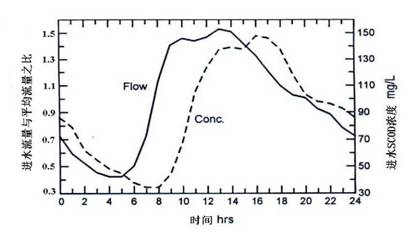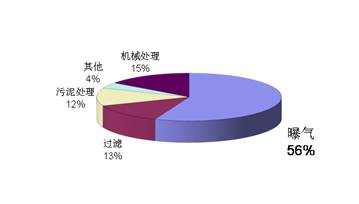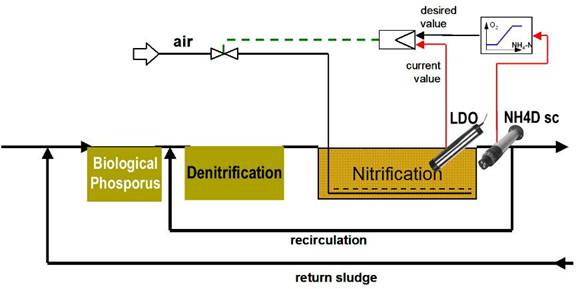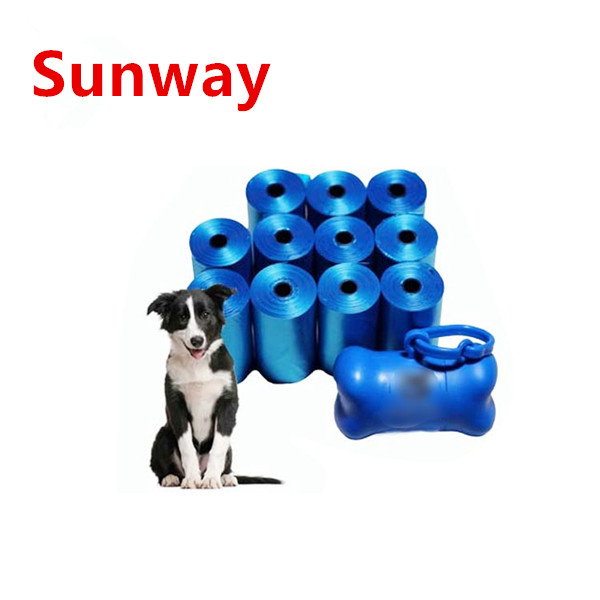Abstract: With the continuous development of the economy and the gradual improvement of environmental protection requirements, more and more sewage treatment plants have been constructed in China. The optimal operation of sewage treatment plants is particularly important. On the one hand, the normal operation of the sewage treatment plant needs to be optimized to save energy and reduce emissions; on the one hand, because the emission standards of the sewage treatment plant are also becoming stricter, they need to be optimized to improve the treatment capacity. We know that aeration is the core of the entire sewage treatment process, and energy consumption accounts for more than half of the entire sewage treatment plant, so optimizing aeration has practical significance and huge energy saving potential. At present, most sewage treatment plants adopt the "rough" aeration method. As long as the effluent reaches the discharge standard, the amount of aeration will basically not change. Only when the effluent water quality (ammonia nitrogen, total nitrogen, etc.) exceeds the standard, the aeration amount will be changed. When the influent load changes, the effluent water quality will fluctuate. When the influent load is too high, the effluent will exceed the standard; when the influent load is low, it will cause waste. The application of online water quality analysis instruments in the sewage treatment plant can monitor the inflow load in real time, thereby realizing precise optimized aeration control. Keywords: precise aeration; on-line water quality analysis instrument; energy saving and consumption reduction; sewage treatment; optimized operation The application of online instrument for exact aeration in WWTP Weiming Huang, Yunzhi Wu (Hach company Beijing representative Beijing 100004) Abstract: With the continual development of economic and rising environmental requirements, more and more wastewater treatment plants have to be built in China. It's especially important to do optimization for WWTP. On the one hand, the operation of the WWTP need optimization for energy saving ; on the other hand, the emission standards are more and more stringent, it need to enhanced the treatment ability of the WWTP by optimization. As we all know aeration process is the core of the whole WWTP's process, and consume more than half of energy consumption of WWTP, so it make sense to optimize aeration and we could get large savings. At present most WWTP do not have exact aeration control. The aeration volume only be changed when the water quality (NH4-N, TN, etc.) exceed limit. The water quality of outlet will fluctuate when load of inflow changed. Higher load of inflow will lead to exceed limit of outlet, while lower load of inflow make waste of energy. Online water quality analyzer in the wastewater treatment plant, making it possible to monitor hydraulic load of inflow water online, and to carry out the exact aeration contral. Keyword: exact aeration; online water quality analyzer; energy efficiency; wastewater treatment; optimized operation The development of urbanization has led to an increase in the discharge of urban sewage. At present, the discharge of urban domestic sewage is about 40 billion tons per year. By the end of 2010, there were 2832 urban sewage treatment plants in China, with a daily treatment capacity of 125 million cubic meters, and an urban sewage treatment rate of 77.4%. During the "Twelfth Five-Year Plan" period, the state will further increase its support for urban sewage treatment, and the control of total nitrogen and total phosphorus will be put on the agenda. The development of sewage treatment in China will also shift to improving the efficiency of sewage treatment plants. 1. Background Introduction At present, the outlets of sewage treatment plants in China are generally equipped with online water quality analysis instruments, while the detection of influent water quality relies on laboratory testing. Online water quality analysis instruments are relatively few and the detection frequency is low. However, for sewage treatment plants, the influent flow rate and COD concentration are constantly changing, as shown in Figure 1 for the typical daily influent load curve of the sewage treatment plant. If the quality of the influent water is not understood, the process parameters of the sewage treatment plant will not be adjusted in time, which ultimately leads to large fluctuations in the effluent water quality. In order to ensure that the effluent reaches the discharge standard, the process parameters are generally set according to the maximum influent load. This conservative operating mode has a large margin, low efficiency, and a lot of waste. When the impact load occurs, the process parameters cannot be adjusted in time, and the effluent water quality exceeds the standard. For sewage treatment plants using activated sludge processes, the energy consumed by aeration accounts for more than half of all energy consumption of sewage treatment plants, as shown in Figure 2. Therefore, precise control of aeration has great potential for energy saving. A complete denitrification process includes nitrification and denitrification processes. The nitrification process is to convert ammonia nitrogen into nitrate under aerobic environment, which requires aeration; the denitrification process is to convert nitrate nitrogen into nitrogen under anoxic environment, without aeration. If the sewage treatment plant wants to meet the standards of ammonia nitrogen and total nitrogen in the effluent, and has high treatment efficiency, it is necessary to accurately control the aeration. 2. Precise aeration control The typical aeration control types of sewage treatment plants are mainly divided into two categories: The first category is to directly control the fan, as shown in Figure 3. The system collects the dissolved oxygen value measured by the dissolved oxygen analyzer installed in the aerobic tank and compares it with the system setting value (this setting value can be set by the user). If the actual dissolved oxygen value is greater than the set value, reduce the fan speed, thereby reducing the amount of aeration, and gradually reduce the dissolved oxygen in the aerobic tank, eventually consistent with the set value. If the actual deoxygenation value is smaller than the set value, the fan speed is increased, thereby increasing the aeration amount, and gradually increasing the dissolved oxygen in the aerobic tank, and finally consistent with the set value. For this control method, the air pressure of the aeration pipeline will fluctuate to a certain extent, which is not conducive to the control of aeration. It is generally used for aeration control of small sewage treatment plants. The second type is to directly control the valve, as shown in Figure 4. The system collects the actual dissolved oxygen value and compares it with the system set value, according to the first type of control mode to control the valve opening. At the same time, the system collects the pressure of the aeration pipeline and compares it with the pressure setting. If the actual pressure is greater than the set value, the fan speed is reduced; if the actual pressure is less than the set value, the fan speed is increased; eventually the pressure of the aeration pipe is kept constant. For this control method, when the pressure of the aeration pipeline is constant, the linear relationship between the valve opening and the aeration amount is better, and the aeration amount can be controlled better. It is generally used for aeration in large and medium-sized sewage treatment plants. control. The above aeration control can control the dissolved oxygen concentration of the aerobic tank. Due to the continuous change of the inlet water load, such aeration control can not adjust the aeration amount according to the inlet water load, but it is precisely controlled by aeration Part of it is also a prerequisite for precise aeration control. Precise aeration control adopts automatic control theory to accurately adjust the aeration amount according to the change of influent load and effluent water quality, so that the aeration amount can just meet the needs of sewage treatment, achieve stable effluent, and can save energy and reduce consumption, and enhance sewage Treatment plant stability. Precise aeration control is divided into open-loop control, closed-loop control and composite control. Since the factors that affect the nitrification function of the aeration tank are relatively complex, open-loop control is generally not used and will not be described here. As shown in Figure 5, the closed loop control system for precise aeration is based on typical aeration control. The instruments required by the system are the online dissolved oxygen analyzer installed in the aeration tank and the online ammonia nitrogen analyzer installed at the end of the aeration tank. The system collects the ammonia nitrogen concentration value at the end of the aeration tank and compares it with the set value. If the actual ammonia nitrogen concentration value is higher than the set value, it means that the nitrification capacity of the aeration tank is not enough to convert the ammonia nitrogen load of the influent into nitrate nitrogen. Oxygen set point to improve the nitrification capacity of the aeration tank. If the actual ammonia nitrogen concentration value is lower than the set value, it means that the nitrification capacity of the aeration tank is surplus relative to the ammonia nitrogen load of the influent. The dissolved oxygen set value of the aeration tank can be reduced to reduce the nitrification capacity of the aeration tank. Save energy consumption. Because the closed-loop control system measures ammonia nitrogen after the aeration tank, it belongs to post-feedback control, which can ensure that the effluent meets the discharge standard, but it cannot respond to the load changes in time, and has a certain lag. As shown in Figure 6, it is a precise aeration composite control system, which is built on the basis of a precise aeration closed-loop control system to increase the front feedback control, which can know the change of the inlet water load in advance and solve the lag problem of the back feedback control. The system collects the ammonia nitrogen concentration value measured by the online ammonia nitrogen analyzer in front of the anaerobic tank, and uses the activated sludge model and the automatic control theory. At the same time, the hysteresis effect from the anaerobic tank to the aeration tank is considered, and the dissolved oxygen setting of the aeration tank is calculated. Value. The ammonia nitrogen value in the inlet of the biological reaction tank increases, and the set value of dissolved oxygen in the aeration tank increases accordingly; the ammonia nitrogen value decreases, and the set value of dissolved oxygen in the aeration tank decreases accordingly. Of course, the precise aeration closed-loop control described above still plays a leading role in the composite control system. When the feed-forward control requires the dissolved oxygen set value to decrease, and the closed-loop control requires the dissolved oxygen set value to increase, the closed-loop control should be used mainly to increase the dissolved oxygen set value; otherwise, the current feed control requires the dissolved oxygen set value When the value increases, and the closed-loop control requires the dissolved oxygen setpoint to decrease, the closed-loop control should be the main method to reduce the dissolved oxygen setpoint. The compound control system has a certain amount of advance, and can ensure that the effluent ammonia nitrogen meets the discharge standard, which is an ideal and accurate aeration control method. 3. Summary By applying the above-mentioned precise aeration control system, the aeration volume can be adjusted according to the influent load to adapt the aeration volume to the influent load, saving aeration on the basis of ensuring stable effluent water quality, and achieving energy saving and consumption reduction. At the same time, because the aeration volume of the aeration tank is just enough, there will be no excess oxygen flowing into the anoxic tank with the internal reflux, and it will not destroy the denitrification function of the anoxic tank. Therefore, the precise aeration control guarantees the denitrification function while optimizing the nitrification function, and can achieve the stable discharge of ammonia nitrogen and total nitrogen with the minimum energy consumption. We know that the first-grade A effluent standard of sewage treatment plants is ammonia nitrogen effluent concentration <5mg / L and total nitrogen 15mg / L. According to investigations, the ammonia nitrogen in the effluent of many sewage treatment plants is less than 1mg / L, even reaching 0.1mg / L. This shows that aeration has a large surplus and has great potential for energy saving. The application of precise aeration control system can increase the ammonia nitrogen in the effluent to about 4mg / L without exceeding the standard, which naturally saves the energy consumption of aeration. In theory, the use of a precise aeration control system can save 10-30% of aeration. The Peel Common sewage treatment plant in the south of England is one of the sewage treatment plants established in the early days of the United Kingdom. It adopts the 4-level Bardenpho process, that is, adding aeration and anoxic zone at the end of the aerobic zone of the traditional A2O process to enhance denitrification. Water treatment capacity is about 60,000 m3 / d, serving a population of 250,000. In 2008, a real-time control system for sewage treatment, namely RTC system, was installed, which included a precise aeration control system. The system uses Hach's online water quality analysis instruments (ammonia nitrogen, nitrate nitrogen, dissolved oxygen, sludge concentration, etc.) and WTOS control system, saving 20% ​​of the aeration. Any instrument will fail, and the online water quality analysis instrument is more prone to failure due to long-term immersion operation in sewage. We know that the online analytical instrument belongs to the sensor in the control, which is equivalent to the eye of the entire control system. When a fault occurs, it will not work properly. The WTOS control system is fully prepared for this, and the PROGNOSYS module is designed to be able to judge the running status of the online analytical instrument. When the online analytical instrument needs maintenance or fails, an alarm will be given. When an abnormal condition is detected, the WTOS control system will start the fault operation mode, so as to achieve the reliability of the control and avoid being unable to control in the abnormal condition. On-line water quality analysis instruments are used in sewage treatment plants, which can realize continuous detection of water quality, provide effective and reliable measured values ​​for various optimized controls such as precise aeration, thereby improving treatment efficiency and achieving energy saving and consumption reduction. With the continuous improvement of the mathematical model of sewage treatment technology, the continuous application of process control theory in sewage treatment plants, and the continuous progress of online detection instrument technology, we can apply more optimized control strategies in sewage treatment plants, and ultimately improve the sewage treatment plant. The level of operation and management meets increasingly strict emission standards. references: [1] Li Jun, Peng Yongzhen, Gu Guowei, etc. Research on SBR Online Control System for Denitrification and Phosphorus Removal of Urban Wastewater [J]. Water Supply and Drainage, 2006, (9): 93 [2] Uwe Karg, Li Junying, Cheng Li, Fang Wen. Application of on-line detection in the process of denitrification and dephosphorization of urban sewage [J]. Water Industry Market, 2008, 10: 28-31. [3] Lin Jidong. Research on the Change Law of Inlet Water Quality Index of Huangjiahu Sewage Treatment Plant [J]. Foreign Building Materials Science and Technology, 2005, 6 (5): 74-76. [4] Qin Yanping. Discussion on the current situation and development of urban sewage treatment in China [J]. Science and Technology to Promote Development, 2009, 4: 256.
Many people like pet , just like dogs and cats , but how to clear the dog's poop is a headache problem , some people put it in the plastic bags and throw it into the garbage can , these plastic bags caused serious environment pollutions , how to reduce these pollutions ? Sunway is keep on developing and producing Biodegradable Material is more than 20 years , our Biodegradable Dog Poop Bags can be broken down to CO2 and water within 6 months out of doors , all the products have got the certificates of ROHS , SGS , FDA, ISO9000 & ISO14000 etc, we are deeply understanding customer's requirements and environment protection, From product design to material purchasing, samples making, mass production, shipping and after-sales service. each procedure is performed strict quality control, products are mainly sold to Europe, America, Japan, Korea, Middle East, southeast Asia and other countries, if you need please contact us freely , thanks !
Biodegradable Dog Poop Bags Biodegradable Dog Poop Bags,Biodegradable Poop Bags,Biodegradable Pet Waste Bags,Biodegradable Pet Poop Bags Shenzhen Sunway Packaging Material Co., Ltd , https://www.sunwaypack.com Figure 1. Daily water inlet load curve
Figure 1. Daily water inlet load curve  Figure 2. Distribution of energy consumption of sewage treatment plant
Figure 2. Distribution of energy consumption of sewage treatment plant  Figure 3. Aeration control of a small sewage treatment plant
Figure 3. Aeration control of a small sewage treatment plant  Figure 4: Aeration control of large and medium-sized sewage treatment plants
Figure 4: Aeration control of large and medium-sized sewage treatment plants  Figure 5. Closed-loop control of precise aeration
Figure 5. Closed-loop control of precise aeration  Figure 6. Precise aeration composite control
Figure 6. Precise aeration composite control 

